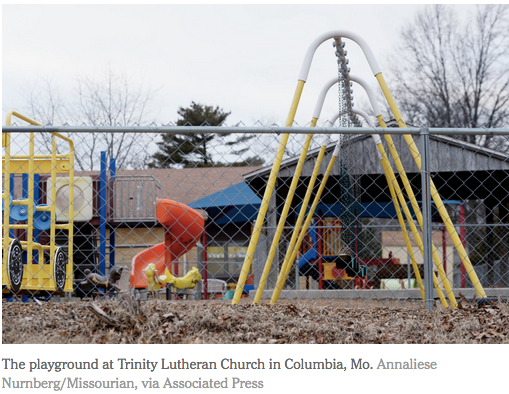In the interest of child safety, Missouri provides a limited number of state grants to playground operators to replace hard surfaces with rubber. Trinity Lutheran Church, in the town of Columbia, applied for one of those grants in 2012 to upgrade the playground for its day care and preschool. The state refused to provide the funds because Missouri’s Constitution bars spending any money “directly or indirectly, in aid of any church.”
The church sued, arguing that the prohibition violated both the First Amendment and the Equal Protection Clause of the 14th Amendment of the United States Constitution. The state countered that the church was free to practice its religion without interference; it just couldn’t demand that taxpayers subsidize it.
If the court invalidates Missouri’s prohibition — versions of which exist in the constitutions of 38 other states — the effects could reach far beyond playground surfaces. For starters, religious schools would have a much easier time taking advantage of state-funded voucher programs, which are likely to grow under the Trump administration.
Church Wins Ruling Over Access to Public Funding
Chief Justice John G. Roberts Jr., writing for the majority, said unjustified government discrimination against churches and other religious institutions is odious and unconstitutional. Officials in Missouri, Chief Justice Roberts wrote, were not entitled to reject a 2012 application from Trinity Lutheran Church, in Boone County, Mo., for a grant to use recycled tires to resurface a playground.
“The consequence is, in all likelihood, a few extra scraped knees,” Chief Justice Roberts wrote. “But the exclusion of Trinity Lutheran from a public benefit for which it is otherwise qualified, solely because it is a church, is odious to our Constitution all the same, and cannot stand.”
Justice Sonia Sotomayor summarized her dissent from the bench, an indication of deep disagreement.
“This case is about nothing less than the relationship between religious institutions and the civil government — that is, between church and state,” Justice Sotomayor wrote in her dissent, which was joined by Justice Ruth Bader Ginsburg. “The court today profoundly changes that relationship by holding, for the first time, that the Constitution requires the government to provide public funds directly to a church.”
. . .
“The church has a religious mission, one that it pursues through the learning center,” she wrote. “The playground surface cannot be confined to secular use any more than lumber used to frame the church’s walls, glass stained and used to form its windows, or nails used to build its altar.”
More broadly, she wrote, states should be allowed to make their own judgments about whether to support religious groups.
“The constitutional provisions of 39 states — all but invalidated today — the weighty interests they protect, and the history they draw on deserve more than this judicial brush aside,” Justice Sotomayor wrote, adding that the decision may have unintended consequences.
“In the end, the soundness of today’s decision may matter less than what it might enable tomorrow,” Justice Sotomayor wrote. “The principle it establishes can be manipulated to call for a similar fate for lines drawn on the basis of religious use.”




